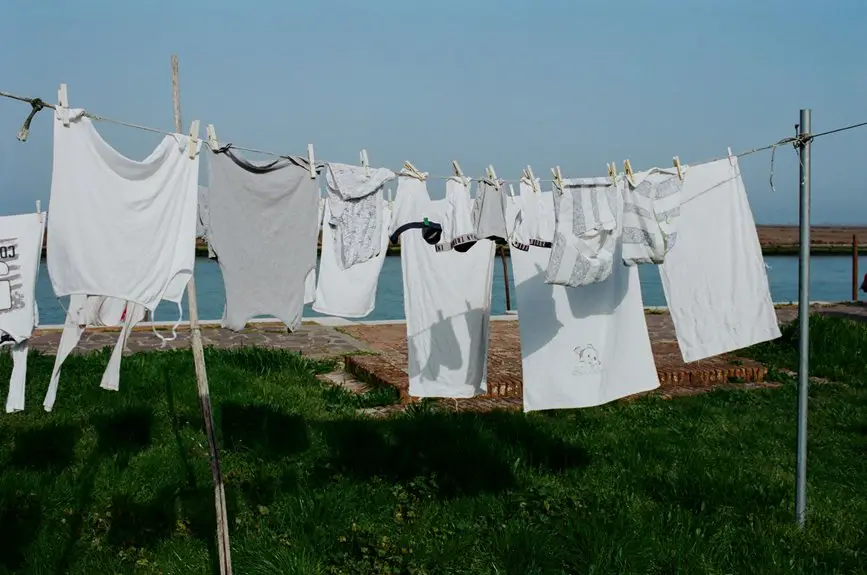When summer heat hits, choosing the right fabric can make all the difference in comfort. You might reach for cotton out of habit, but have you considered how linen’s unique fiber structure could keep you cooler? Understanding how each material handles air and moisture could change the way you dress for warm weather. Before you decide on your next summer outfit, it’s worth examining how these fabrics perform under the sun.
Table of Contents
Key Takeaways
- Linen’s hollow fibers create more gaps, allowing better air flow and enhanced breathability than cotton in summer.
- Cotton’s denser, smoother fibers trap heat, reducing its breathability compared to linen.
- Linen quickly wicks moisture away and dries faster, keeping the wearer cooler and drier.
- Cotton absorbs moisture but retains it longer, often causing a sticky, uncomfortable feel in heat.
- Overall, linen’s superior air permeability and moisture management make it the better breathable fabric for summer.
The Science Behind Fabric Breathability
Although both linen and cotton are popular choices for summer clothing, their breathability differs due to the way their fibers interact with air and moisture.
Linen and cotton both suit summer, but their breathability varies with fiber structure and moisture interaction.
You’ll find that linen’s fiber structure is naturally hollow and rougher, which creates more gaps between threads. This design boosts linen’s air permeability, allowing air to flow freely and keep you cooler.
Cotton fibers, on the other hand, are smoother and denser, resulting in less space for air to pass through. When you wear linen, it feels lighter because the fabric allows heat and moisture to escape quickly.
In contrast, cotton traps a bit more heat due to its tighter fiber arrangement. Understanding these differences helps you choose the best fabric to stay comfortable during hot weather.
Comparing Moisture Management in Linen and Cotton
When you’re choosing between linen and cotton for summer, how each fabric handles moisture plays a big role in your comfort.
Linen excels in moisture absorption, pulling sweat away from your skin quickly. It also boasts a faster drying speed compared to cotton, so you won’t feel damp for long.
Cotton, while highly absorbent, tends to hold onto moisture longer, which can leave you feeling sticky when temperatures rise.
If you’re active or in humid conditions, linen’s superior ability to wick moisture and dry rapidly keeps you cooler and more comfortable.
Understanding these differences helps you pick the right fabric for your summer wardrobe, ensuring you stay fresh and dry no matter how hot it gets.
Comfort and Cooling Effects of Linen vs. Cotton
Moisture management directly impacts how comfortable and cool you feel in summer fabrics. When you wear breathable fabrics like linen and cotton, your skin can stay dry and fresh, reducing that sticky, uncomfortable feeling.
Linen excels in this by quickly wicking moisture away and allowing air to circulate, which enhances summer comfort. Cotton, while also breathable, tends to hold onto moisture longer, making it less effective at cooling you down during intense heat.
If you prioritize staying cool and dry, linen often outperforms cotton because of its open weave and natural fiber properties.
Durability and Longevity: Which Fabric Lasts Longer?
If you want your summer clothes to hold up season after season, understanding the durability of linen and cotton is essential.
When you look at a durability comparison, linen often edges out cotton because its fibers are stronger and more resistant to wear and tear. You’ll find linen withstands repeated washing without losing shape or texture, which boosts its longevity factors.
Cotton, while softer initially, tends to weaken faster, especially if exposed to frequent washing or harsh conditions. However, high-quality cotton can still last long if you handle it properly.
Style, Versatility, and Seasonal Suitability of Linen and Cotton
Both linen and cotton offer unique style and versatility that suit different summer occasions, making them staples in warm-weather wardrobes.
Linen’s natural texture and relaxed drape align perfectly with casual, breezy fashion trends, ideal for beach days or outdoor gatherings. It’s your go-to for effortless seasonal outfits that feel cool and stylish.
Cotton, on the other hand, adapts well to various cuts and prints, letting you easily switch from casual tees to polished summer dresses or shirts. Its softness and breathability make it great for everyday wear and layering.
Whether you want a laid-back look or something more refined, you’ll find both fabrics fit seamlessly into your summer style, keeping you comfortable and on-trend throughout the season.
Frequently Asked Questions
How Do Linen and Cotton Fabrics Hold up to Frequent Washing?
You’ll notice a durability comparison shows linen holds up well to frequent washing but may soften and wrinkle more, while cotton withstands washing effects sturdily, maintaining shape and color longer with proper care.
Are There Specific Care Instructions Unique to Linen Compared to Cotton?
Imagine you’ve just bought a linen shirt; you’ll want to follow specific care tips like washing it in lukewarm water to maintain fabric maintenance. Unlike cotton, linen requires gentle handling to avoid damage and preserve its texture.
Can Linen or Cotton Fabrics Cause Allergies or Skin Irritation?
You might experience allergy triggers or skin sensitivity with both linen and cotton, depending on your skin type and fabric treatment. Choosing organic, untreated fabrics can help minimize irritation and keep your skin comfortable.
What Environmental Impacts Are Associated With Producing Linen Versus Cotton?
You might expect both fabrics to impact the environment similarly, but linen uses far less water and involves more sustainable practices compared to cotton. So, when choosing, you’re supporting a greener, more eco-friendly textile industry.
How Do Price Points Generally Compare Between Linen and Cotton Clothing?
When you consider price points, linen tends to be pricier due to its durability and fabric quality. Cotton offers better affordability. Your choice depends on whether you prioritize budget or long-lasting, high-quality fabric.
- Kevlar Cloth (DuPont): Specifications and Industrial Uses - June 21, 2025
- Kevlar Class IIIA Fabric: Ballistic Protection Explained - June 21, 2025
- Kevlar Carbon Fiber in China: Market Analysis and Reviews - June 21, 2025





